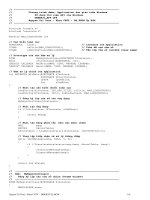04 explicit free lists 10 36 tủ tài liệu bách khoa
Bạn đang xem bản rút gọn của tài liệu. Xem và tải ngay bản đầy đủ của tài liệu tại đây (173.27 KB, 16 trang )
University
of
Washington
Sec3on
10:
Memory
Alloca3on
Topics
¢
Dynamic
memory
alloca3on
§ Size/number
of
data
structures
may
only
be
known
at
run
7me
§ Need
to
allocate
space
on
the
heap
§ Need
to
de-‐allocate
(free)
unused
memory
so
it
can
be
re-‐allocated
¢
Implementa3on
§ Implicit
free
lists
§ Explicit
free
lists
–
subject
of
next
programming
assignment
§ Segregated
free
lists
¢
¢
Garbage
collec3on
Common
memory-‐related
bugs
in
C
programs
Memory
Alloca3on
Implementa3on
University
of
Washington
Keeping
Track
of
Free
Blocks
¢
Method
1:
Implicit
free
list
using
length—links
all
blocks
5
¢
¢
6
2
Method
2:
Explicit
free
list
among
the
free
blocks
using
pointers
5
4
4
6
2
Method
3:
Segregated
free
list
§ Different
free
lists
for
different
size
classes
¢
Method
4:
Blocks
sorted
by
size
§ Can
use
a
balanced
tree
(e.g.
Red-‐Black
tree)
with
pointers
within
each
free
block,
and
the
length
used
as
a
key
Memory
Alloca3on
Implementa3on
University
of
Washington
Explicit
Free
Lists
Allocated
block:
size
Free
block:
a
size
a
next
prev
payload
and
padding
size
a
size
a
(same
as
implicit
free
list)
¢
Maintain
list(s)
of
free
blocks,
rather
than
implicit
list
of
all
blocks
§ The
“next”
free
block
could
be
anywhere
in
the
heap
So
we
need
to
store
forward/back
pointers,
not
just
sizes
§ Luckily
we
track
only
free
blocks,
so
we
can
use
payload
area
for
pointers
§ S7ll
need
boundary
tags
for
coalescing
§
Memory
Alloca3on
Implementa3on
University
of
Washington
Explicit
Free
Lists
¢
Logically
(doubly-‐linked
lists):
A
¢
B
C
Physically:
blocks
can
be
in
any
order
Forward
(next)
links
A
4
B
4
4
4
6
6
4
C
Memory
Alloca3on
Implementa3on
4
4
4
Back
(prev)
links
University
of
Washington
Alloca3ng
From
Explicit
Free
Lists
conceptual
graphic
Before
A:er
(with
spli>ng)
= malloc(…)
Memory
Alloca3on
Implementa3on
University
of
Washington
Freeing
With
Explicit
Free
Lists
¢
InserAon
policy:
Where
in
the
free
list
do
you
put
a
newly
freed
block?
§ LIFO
(last-‐in-‐first-‐out)
policy
§
Insert
freed
block
at
the
beginning
of
the
free
list
§
Pro:
simple
and
constant
7me
Con:
studies
suggest
fragmenta7on
is
worse
than
address
ordered
§
§ Address-‐ordered
policy
§
Insert
freed
blocks
so
that
free
list
blocks
are
always
in
address
order:
addr(prev)
<
addr(curr)
<
addr(next)
§
Con:
requires
linear-‐7me
search
when
blocks
are
freed
Pro:
studies
suggest
fragmenta7on
is
lower
than
LIFO
§
Memory
Alloca3on
Implementa3on
University
of
Washington
Freeing
With
a
LIFO
Policy
(Case
1)
conceptual
graphic
Before
free( )
Root
¢
Insert
the
freed
block
at
the
root
of
the
list
A:er
Root
Memory
Alloca3on
Implementa3on
University
of
Washington
Freeing
With
a
LIFO
Policy
(Case
2)
conceptual
graphic
Before
free( )
Root
¢
Splice
out
predecessor
block,
coalesce
both
memory
blocks,
and
insert
the
new
block
at
the
root
of
the
list
A:er
Root
Memory
Alloca3on
Implementa3on
University
of
Washington
Freeing
With
a
LIFO
Policy
(Case
3)
conceptual
graphic
Before
free( )
Root
¢
Splice
out
successor
block,
coalesce
both
memory
blocks
and
insert
the
new
block
at
the
root
of
the
list
A:er
Root
Memory
Alloca3on
Implementa3on
University
of
Washington
Freeing
With
a
LIFO
Policy
(Case
4)
conceptual
graphic
Before
free( )
Root
¢
Splice
out
predecessor
and
successor
blocks,
coalesce
all
3
memory
blocks
and
insert
the
new
block
at
the
root
of
the
list
A:er
Root
Memory
Alloca3on
Implementa3on
University
of
Washington
Explicit
List
Summary
¢
Comparison
to
implicit
list:
§ Allocate
is
linear
7me
in
number
of
free
blocks
instead
of
all
blocks
Much
faster
when
most
of
the
memory
is
full
§ Slightly
more
complicated
allocate
and
free
since
needs
to
splice
blocks
in
and
out
of
the
list
§ Some
extra
space
for
the
links
(2
extra
words
needed
for
each
block)
§ Possibly
increases
minimum
block
size,
leading
to
more
internal
fragmenta7on
§
¢
Most
common
use
of
explicit
lists
is
in
conjunc3on
with
segregated
free
lists
§ Keep
mul7ple
linked
lists
of
different
size
classes,
or
possibly
for
different
types
of
objects
Memory
Alloca3on
Implementa3on
University
of
Washington
Keeping
Track
of
Free
Blocks
¢
Method
1:
Implicit
list
using
length—links
all
blocks
5
¢
¢
6
2
Method
2:
Explicit
list
among
the
free
blocks
using
pointers
5
4
4
6
2
Method
3:
Segregated
free
list
§ Different
free
lists
for
different
size
classes
¢
Method
4:
Blocks
sorted
by
size
§ Can
use
a
balanced
tree
(e.g.
Red-‐Black
tree)
with
pointers
within
each
free
block,
and
the
length
used
as
a
key
Memory
Alloca3on
Implementa3on
University
of
Washington
Segregated
List
(Seglist)
Allocators
¢
Each
size
class
of
blocks
has
its
own
free
list
1-‐2
3
4
5-‐8
9-‐inf
¢
¢
O[en
have
separate
classes
for
each
small
size
For
larger
sizes:
One
class
for
each
two-‐power
size
Memory
Alloca3on
Implementa3on
University
of
Washington
Seglist
Allocator
¢
Given
an
array
of
free
lists,
each
one
for
some
size
class
¢
To
allocate
a
block
of
size
n:
§ Search
appropriate
free
list
for
block
of
size
m
>
n
§ If
an
appropriate
block
is
found:
Split
block
and
place
fragment
on
appropriate
list
(op7onal)
§ If
no
block
is
found,
try
next
larger
class
§ Repeat
un7l
block
is
found
§
¢
If
no
block
is
found:
§ Request
addi7onal
heap
memory
from
OS
(using
sbrk())
§ Allocate
block
of
n
bytes
from
this
new
memory
§ Place
remainder
as
a
single
free
block
in
largest
size
class
Memory
Alloca3on
Implementa3on
University
of
Washington
Seglist
Allocator
(cont.)
¢
To
free
a
block:
§ Coalesce
and
place
on
appropriate
list
(op7onal)
¢
Advantages
of
seglist
allocators
§ Higher
throughput
log
7me
for
power-‐of-‐two
size
classes
§ BeYer
memory
u7liza7on
§
§
First-‐fit
search
of
segregated
free
list
approximates
a
best-‐fit
search
of
en7re
heap.
§
Extreme
case:
Giving
each
block
its
own
size
class
is
equivalent
to
best-‐fit.
Memory
Alloca3on
Implementa3on
University
of
Washington
Summary
of
Key
Allocator
Policies
¢
Placement
policy:
§ First-‐fit,
next-‐fit,
best-‐fit,
etc.
§ Trades
off
lower
throughput
for
less
fragmenta7on
§ ObservaAon:
segregated
free
lists
approximate
a
best
fit
placement
policy
without
having
to
search
en7re
free
list
¢
Spli`ng
policy:
§ When
do
we
go
ahead
and
split
free
blocks?
§ How
much
internal
fragmenta7on
are
we
willing
to
tolerate?
¢
Coalescing
policy:
§ Immediate
coalescing:
coalesce
each
7me
free()
is
called
§ Deferred
coalescing:
try
to
improve
performance
of
free()
by
deferring
coalescing
un7l
needed.
Examples:
§ Coalesce
as
you
scan
the
free
list
for
malloc()
§ Coalesce
when
the
amount
of
external
fragmenta7on
reaches
some
threshold
Memory
Alloca3on
Implementa3on









